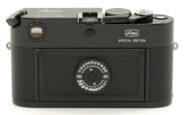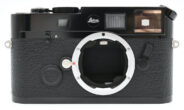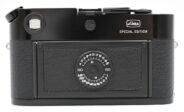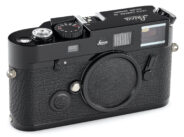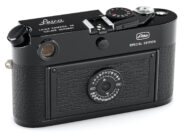Leica M6 TTL "LHSA Special Edition"
35mm MF film rangefinder camera • Collectible
Specification
| Production details: | |
| Announced: | 2000 |
| Production type: | Small-batch production: 1150 (one thousand one hundred fifty) units |
| Order No.: | 10443 - 0.72, black paint |
| 10479 - 0.85, black paint | |
| System: | ● Leica M (1954) |
| Format: | |
| Maximum format: | 35mm full frame |
| Film type: | 135 cartridge-loaded film |
| Mount and Flange focal distance: | Leica M [27.8mm] |
| Shutter: | |
| Type: | Focal-plane |
| Model: | Mechanical |
| Speeds: | 1 - 1/1000 + B |
| Exposure: | |
| Exposure metering: | Through-the-lens (TTL), stop-down |
| Exposure modes: | Manual |
| Rangefinder and Viewfinder: | |
| Rangefinder: | Built-in, combined with viewfinder |
| Viewfinder: | Built-in, combined with rangefinder |
| Finder magnification: | 0.72x |
| 0.85x | |
| Actual rangefinder base: | 69.25mm |
| Effective rangefinder base: | 49.86mm - with 0.72x |
| 58.86mm - with 0.85x | |
| Bright-line frames: | 28mm & 90mm, 35mm & 135mm, 50mm & 75mm - with 0.72x |
| 35mm & 135mm, 50mm & 75mm, 90mm - with 0.85x | |
| Parallax compensation: | Yes |
| Physical characteristics: | |
| Weight: | <No data> |
| Dimensions: | 138x79.5x38mm |
Manufacturer description
LHSA SPECIAL EDITION BLACK PAINT M6 TTL
This is a limited-time subscription offer
The black paint Leica M cameras have always been among the most sought after of all Leicas.
There is probably no model of the Leica that both collectors and users agree about more wholeheartedly as being the most desirable than the black paint M cameras of the 50s and 60s. Be it an MP, M3, M2 or M4, these models have always had a special appeal. The brass underneath the paint gives a warmer feel to the metal and the paint also reflects the light differently than black chrome. It also shows the classic Leica engravings in a different way; the black is deeper and the white engravings are brighter and the camera has a certain glow to it.
Black paint was the traditional finish of the Leica camera, beginning with the UR Leica. This continued through the 1930s, when satin chrome became the prevalent finish. Even so, the black paint camera remained popular with professionals desiring a less obtrusive camera. Production of the last black paint Leica rangefinder, the M4, ceased nearly thirty years ago in favor of the black chrome finish.
The black paint camera is probably the only camera whose looks improve with wear. The camera shows wear in a special way that neither a black or silver chrome camera does. The black paint begins to wear after some use, and with time the brass starts showing through on the edges of the top and bottom covers and on the camera controls and levers. To the Leica cognoscenti, this “brassing” presents a particularly appealing patina. Over time and much use, the brassing takes on a unique pattern, an identifying mark of the way the user has handled his camera with his hands and fingers over the years. These cameras wear their scars with pride, and one can imagine if they could talk, what stories these cameras could tell. These cameras are rarely seen today and are almost certainly never used.
With this in mind, the LHSA has decided to resurrect a classic, the Black Paint Leica M. After more than three years of development in recreating the classic Leica Black Paint M, the LHSA and Leica Camera AG will produce this camera in both versions of the M6 TTL; the standard .72 and .85 high magnification model. The choice is yours.
The LHSA black paint camera closely follows the appearance of the last regular production black paint Leica, the M4. Each top cover is individually milled from solid brass by Leica. The brass top cover, base plate and all controls, levers and knobs are finished in a beautiful, deep black enamel. The traditional Leica “script” has been engraved on the top along with “Leica Camera AG, Solms Germany”. This is the first camera in Leica’s history to be engraved Solms! On the back of the top cover, the LHSA logo has been discretely engraved above the words “SPECIAL EDITION”. The Leica M6 engraving on the front and the strap lug protectors have been deleted in keeping with the classic Leica look. Even the Leica “dot” on the front is painted black. The shutter release ring is finished in polished chrome and the base plate locking catch is satin chrome.
The LHSA Black Paint M camera will be available exclusively to LHSA members for only a limited time. Orders will be taken only during the 90 day subscription period. After this period, the subscription will be closed and no further orders will be taken. The number of cameras produced will be limited to the cameras ordered during this period. Leica has agreed to produce 300 cameras in the first batch, with the balance of the order to be filled after the close of the subscription period. Leica has informed us that it may take up to six months after the close of the subscription period to fill these orders. In order to keep costs down, there will be no “special” boxed sets with lens. The cameras will be supplied in standard packaging and will be shipped directly to the members from Leica Camera, Inc., Northvale, New Jersey. Each camera will include the three year Leica USA Passport Warranty. The standard 0.72 version will be priced at US$ 2,595 and the high magnification 0.85 version will be US$ 2,695. Best of all, there will be no limit to the number of cameras each member can purchase during the subscription period. Please see the details of the terms and conditions of this offer on the order sheet enclosed.
The Leica is considered by many to be the Camera of the Century and what better way to celebrate this than by having an LHSA Special Edition in Black Paint. For those who want to have a unique yet still usable Leica, there is no better way to begin recording the new millennium than with your own black paint M6. Keep it pristine, like new in the box, or use it and put your own unique imprint on it. The choice is yours, or buy two and have the best of both worlds!
Who knows, someone, someday may look at your beautifully brassed M6 and say...
“If this camera could talk, what stories it could tell.”
From the editor
A special limited LEICA M6 TTL black paint finish camera released in 2000 for the Leica Historical Society of America. 650 units with the 0.72 viewfinder and 500 units with the 0.85 viewfinder were produced, 1150 units in total.
Table of contents
Clickable
Leica M system cameras
Clickable
- Leica M (Typ 240)
- Leica M (Typ 262)
- Leica M Monochrom
- Leica M Monochrom (Typ 246)
- Leica M-A (Typ 127)
- Leica M-D (Typ 262)
- Leica M-E (Typ 220)
- Leica M-E (Typ 240)
- Leica M-P (Typ 240)
- Leica M1
- Leica M10
- Leica M10 Monochrom
- Leica M10-D
- Leica M10-P
- Leica M10-R
- Leica M11
- Leica M11 Monochrom
- Leica M11-P
- Leica M2
- Leica M3
- Leica M4
- Leica M4-2
- Leica M4-P
- Leica M5
- Leica M6
- Leica M6 (Typ 2248)
- Leica M6 Panda
- Leica M6 Titanium
- Leica M6 TTL
- Leica M6J
- Leica M7
- Leica M8
- Leica M8.2
- Leica M9
- Leica M9-P
- Leica MD
- Leica MD-2
- Leica MDa
- Leica MP
- Leica MP Original

